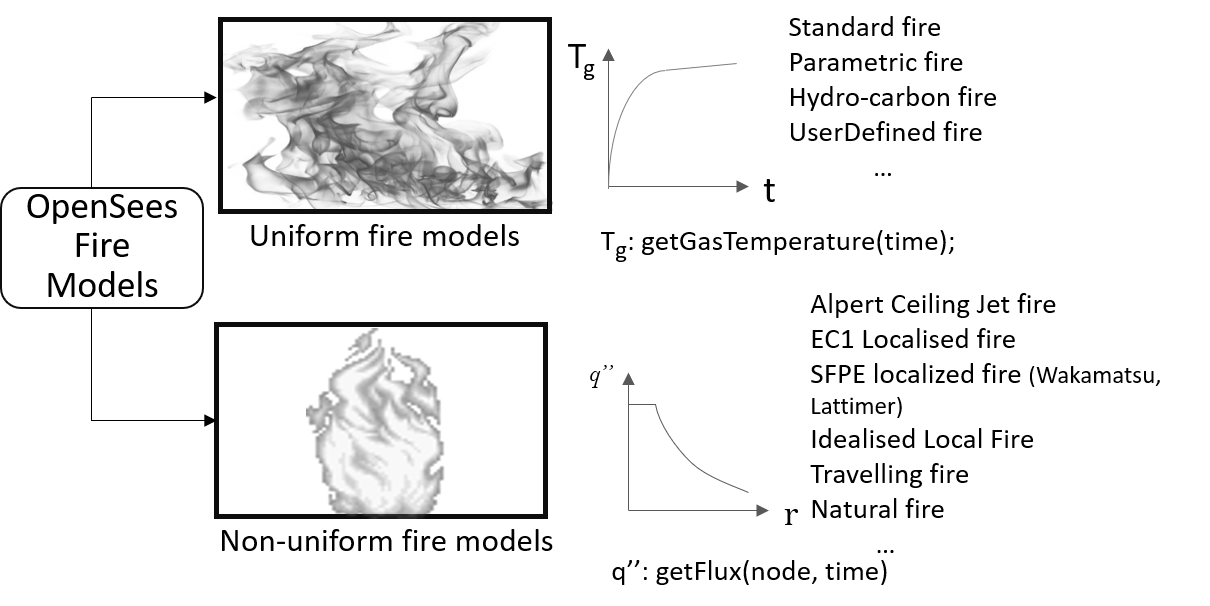Commands for Heat Transfer Analysis in OpenSees
This page explains the commands used for heat transfer analysis in OpenSees
SetInitialT
SetInitialT command is used to initialise the temperature field for all the objects (HTEntity), which is usually assigned with the ambient temperature as the first and only argument following the command.
SetInitialT $initialT;
A very simple example is shown as below
SetInitialT 293.15;
HTConstants
HTConstants command is used to define the co-efficients for heat transfer boundary conditions, which shall be used in associatation with HeatFluxBC command when defining convection and radiation or prescribed heat fluxes.
HTConstants $constantSeriesTag $Convective_Coefficient $ambientT $emissivity $absorptivity ;
HTConstants 1 4.0 293.15 0.7 0.7;
HTPattern
HTPattern command is used to define a time series based load pattern which can be appointed to ambient boudary condition or fire exposure boundary condition.
HTPattern AmbientBc $PatternTag {
HeatFluxBC..... ;
}
HTPattern fire $patternTag model $FireModelTag {
HeatFluxBC..... ;
}
An examples is given as below, which is to define the heat transfer boudanry conditions for the unexposed surface of a concrete slab:
HTPattern AmbientBC 1 {
HeatFluxBC -HTEntity 1 -face 5 -type ConvecAndRad -HTConstants 1;
}
Another example is given here to show how the fire exposure being defined in a heat transfer analysis. A Standard Fire time-temperature relationship curve is adopted to define the fire exposure, and more fire models can be used which can be referred to as FireModel
FireModel 1 -type standard ;
HTPattern fire 2 model 1 {
HeatFluxBC -HTEntity 1 -face 3 -type -ConvecAndRad -HTConstants 1;
}
FireModel
FireModel command is to define various design fire models ready-to-use in OpenSees for fire. Using this command, ideally uniform fire models and ideally non-uniform fire models can be defined. These models may either provide time-variant gas-phase temperatureThe, or time-variant and location-based gauge heat fluxes:
FireModel $fireModelType $fireModelTag <$fireModelPars>;
Parameters for various fire models are given in the following table
| Fire Model | fireModelType | fireModelPars |
| Standard Fire Curve (ISO834, EC1) | standard or Standard | - |
| External Fire Curve (EC1) | external or External | - |
| HydroCarbon Fire Curve (EC1) | HydroCarbon or hydroCarbon | - |
| ASTM Fire Curve | ASTM or ASTME119 | - |
| Parameteric Fire Curve(EC1) | parametric or Parametric | thi,Area_vent, h_vent,Area_total, Area_fire, Q_fire, T_lim |
| Localised fire (EC1) | localised or Localised | -orign $xloc $yloc $zloc -firePars $D $Q $H $symmetricAxisTag |
| Natural Fire Model (Jiang et al,2021( | NaturalFire | -firePars -file $filename |
| User Defined Fire models using external data file | Uerdefined | -file $filename -Type $dataTypeTag |
FireModel standard 1;
FireModel Localised 2 -origin 0.0 -2.0 0.0 -firePars 1.0 1127.0E3 2.4 2 ;
FireModel NaturalFire 6 -firePars -file firepars.dat 2
This page is created by Liming Jiang, 2016